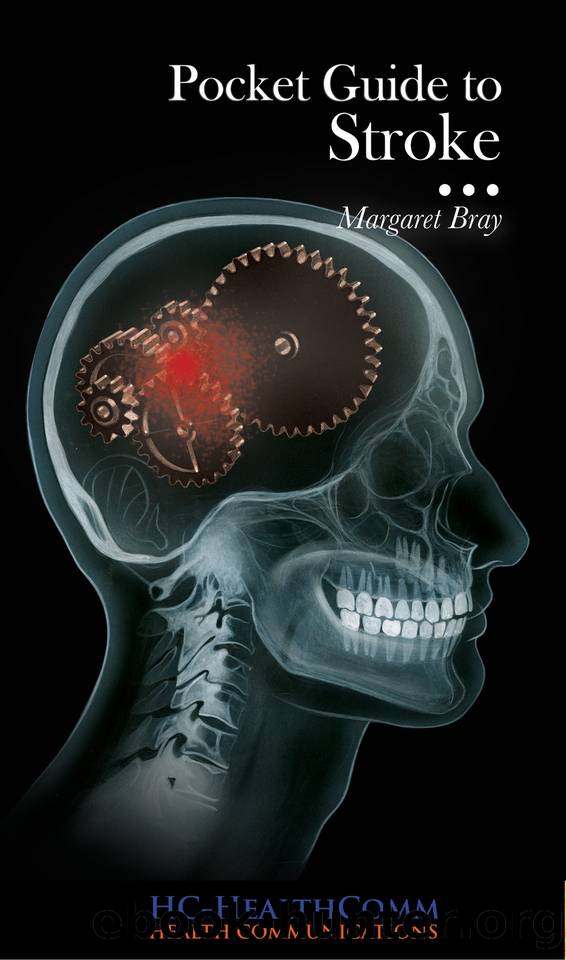Stroke Pocket Guide: Full illustrated by HC-HealthComm

Author:HC-HealthComm [HC-HealthComm]
Language: eng
Format: epub
Publisher: © HC-HealthComm
Published: 2016-02-15T16:00:00+00:00
Some Specific Risk Factors
Hypertension
Hypertension is a major risk factor for all types of stroke - ischemic stroke, intracerebral haemorrhage (ICH), and aneurysmal subarachnoid haemorrhage 34,42,43 Unequivocally the risk of stroke increases progressively with increasing rise in blood pressure and the relationship can be described as “strong, continuous, graded, consistent, independent, predictive an etiologically significant”.44,45,46 Demographic data show that the already high prevalence of hypertension is still on the increase globally. More than two thirds of person over the age of 65 years are hypertensive, and it has been predicted that normotensive 55 year olds have a 90% lifetime risk of developing hypertension.44,47
The JNC 7 report, from which current guidelines on management of hypertensive have been developed, shows that the use of antihypertensive drugs is effective in preventing stroke and other cardiovascular diseases, e.g., heart failure, coronary artery disease and renal failure.44 Furthermore, in a meta analysis of 32 randomized clinical trials with stroke outcomes, anti-hypertensive treatment was shown to significantly reduce the risk of stroke by 32% (95% CI: 24%, 39%; P = 0.004) compared with no drug treatment.48
However, all effective antihypertensive agents have similar efficacy in their ability to reduce stroke risk and no class of anti-hypertensive agent stands out as offering superior protection about any other.34 What is clear though is that the benefits of lowering blood pressure cannot be disputed. Additionally, studies have shown that antihypertensives are effective in reducing stroke risk people with isolated systolic hypertension (systolic/diastolic blood pressure <160/<90 mmHg), a condition that mainly affects the elderly, with risk reductions of 42% with calcium channel blockers and 36% with diuretics observed, although further studies are required in this population.49,50
As well as drug treatment, behavioural and lifestyle changes, e.g., improving diet, taking exercise, stopping smoking) are recommended as part of the treatment strategy (JNC 7 report).44 Not only are these approaches recommended for people with hypertension, but also people classed as having prehypertension (systolic/diastolic blood pressure of 120-139/80-89 mmHg) as part of the primary prevention of the development of full hypertension.46 Actual awareness of having hypertension or prehypertension still has to be addressed since there are a significant number of people who may be unaware of their condition. In a recent survey in the US it was shown that 72% of people with hypertensive were aware they had hypertension, 61% had received treatment, and for 35% their blood pressure was adequately controlled.34 Therefore, a relatively high proportion of people remain undiagnosed or inadequately treated, this tending to be more so in the elderly or minority populations.
Download
This site does not store any files on its server. We only index and link to content provided by other sites. Please contact the content providers to delete copyright contents if any and email us, we'll remove relevant links or contents immediately.
| Administration & Medicine Economics | Allied Health Professions |
| Basic Sciences | Dentistry |
| History | Medical Informatics |
| Medicine | Nursing |
| Pharmacology | Psychology |
| Research | Veterinary Medicine |
Periodization Training for Sports by Tudor Bompa(7936)
Why We Sleep: Unlocking the Power of Sleep and Dreams by Matthew Walker(6376)
Paper Towns by Green John(4812)
The Immortal Life of Henrietta Lacks by Rebecca Skloot(4270)
The Sports Rules Book by Human Kinetics(4087)
Dynamic Alignment Through Imagery by Eric Franklin(3929)
ACSM's Complete Guide to Fitness & Health by ACSM(3830)
Kaplan MCAT Organic Chemistry Review: Created for MCAT 2015 (Kaplan Test Prep) by Kaplan(3811)
Introduction to Kinesiology by Shirl J. Hoffman(3633)
Livewired by David Eagleman(3541)
The River of Consciousness by Oliver Sacks(3424)
The Death of the Heart by Elizabeth Bowen(3348)
Alchemy and Alchemists by C. J. S. Thompson(3304)
Descartes' Error by Antonio Damasio(3168)
Bad Pharma by Ben Goldacre(3113)
The Emperor of All Maladies: A Biography of Cancer by Siddhartha Mukherjee(2941)
The Gene: An Intimate History by Siddhartha Mukherjee(2934)
The Fate of Rome: Climate, Disease, and the End of an Empire (The Princeton History of the Ancient World) by Kyle Harper(2884)
Kaplan MCAT Behavioral Sciences Review: Created for MCAT 2015 (Kaplan Test Prep) by Kaplan(2827)
